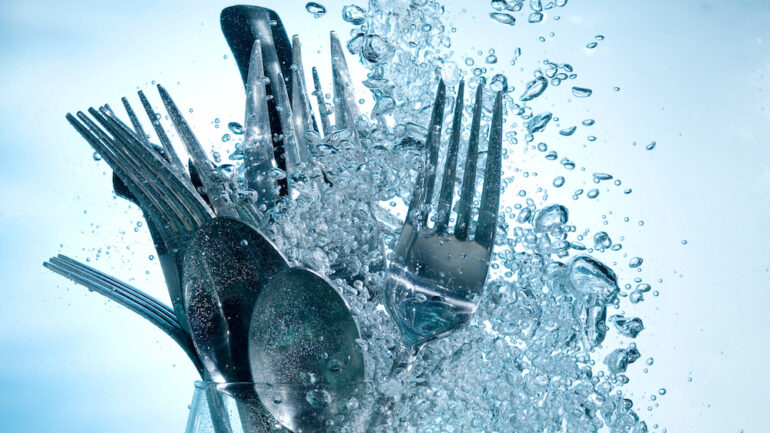You probably use your dishwasher daily, so it seems counterintuitive that you must clean the appliance itself. But dirt and grime can build up in your dishwasher and keep it from working its best. Here’s our guide to cleaning your dishwasher.
How to Clean Your Dishwasher
Food waste and grime can build up in your dishwasher, leaving a bad odor, spots, and film on your dishes. This dirty residue can also damage your dishwasher’s filter and pump, shortening its lifespan. If you have never cleaned your dishwasher, it may need several deep cleanings to remove all the dirt. Afterward, follow a regular cleaning schedule to keep your dishwasher in tip-top shape.
Daily
Wipe or rinse dishes before loading the dishwasher to remove large pieces of food. Remove any detachable labels from containers. After each load, check the bottom of the dishwasher and its filter for visible food or debris.
Weekly
If your dishwasher has a stainless steel door, use a stainless steel cleaner and a microfiber cloth to wipe down the front of the appliance. Or use dish soap and water, buff the door dry, and rub it with a drop of olive or baby oil on a microfiber cloth to remove streaks. If your dishwasher door is not stainless steel, wipe down the exterior and control buttons with mild dish soap or a vinegar and water solution and a microfiber cloth. Rinse with a wet cloth and buff dry.
Using a sponge or damp microfiber cloth, clean the dishwasher door’s edges. Clean inside the rubber gaskets around the door with a toothbrush and soapy water to remove mold and mildew.
Monthly
Each month, deep clean your dishwasher.
- Following the manufacturer’s directions, remove the dishwasher’s filter and soak it in a mixture of water and dishwashing liquid. Remove visible dirt with a toothbrush and rinse the filter. Use distilled white vinegar to remove any stubborn grime. Before replacing the filter, wipe out anything collected inside the drain.
- Clean the machine’s spray arms, which can become clogged. It may be easiest to remove the dishwasher’s racks first. Use a toothbrush and soapy water, and insert a flexible wire into any clogged holes to remove buildup.
- Scrub any visible food or grime out of the utensil holder and soap dispenser with a toothbrush.
- Clean the rubber seals with a vinegar solution and a damp cloth. If the dishwasher still has a bad odor after cleaning, clean the rubber seals where they contact the door with a baking soda-and-water paste and a toothbrush.
- Clean the interior of the dishwasher with a commercial cleaner or a combo of vinegar and baking soda. A commercial cleaner may be better if your dishes are developing a hard water film. If you want to use vinegar and baking soda, never use both at the same time to avoid a mess. Instead, first put a cup of white distilled vinegar in a dishwasher-safe cup or bowl on the top rack of the dishwasher. There’s no need to add soap. Run the machine at its hottest temperature but skip the drying cycle. Next, sprinkle a cup of baking soda on the bottom of the dishwasher’s interior and run a short, hot-water rinse. Never use bleach to clean your dishwasher, as it can corrode stainless steel.
- Leave the dishwasher’s door open so it can air dry.
Related – Let’s Go Shopping for a Dishwasher


